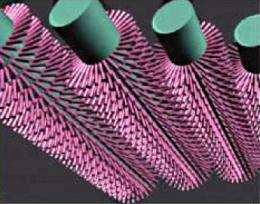March 1, 2012 feature
Tube-shaped solar cells could be woven into clothing

(�鶹��ԺOrg.com) -- Titania semiconducting nanorods grown on the surface of carbon fibers look more like bristles on a tiny hairbrush than a solar cell, but the novel configuration could have several advantages over conventional flat solar cells. For instance, the flexible tube-shaped cells can capture light from all directions and even have the potential to be woven into clothing and paper for novel applications. But at the current stage of development, researchers are trying to find a simple, low-cost method for fabricating high-quality tube-shaped solar cells.
A team of researchers from the Georgia Institute of Technology in Atlanta, Georgia, and Xiamen University in Xiamen, China, have recently developed a new method for preparing uniform titanium dioxide (TiO2) nanorods on carbon fibers. The new method has advantages over the commonly used sol-gel method, which requires high temperatures and can cause cracks in the materials. The new study is published in a recent issue of the Journal of the American Chemical Society.
“This work demonstrates an innovative method for growing bunched TiO2 nanorods on flexible substrates that can be applied to flexible devices for energy harvesting and storage,” coauthor Wenxi Guo from the Georgia Institute of Technology and Xiamen University told �鶹��ԺOrg.com.
Fabricating tube-like solar cells is challenging due to the multiple steps involved, which include transforming pure Ti foil into TiO2 nanorods, coating carbon fibers with the nanorods, and uniformly arranging the nanorods on the fibers. As the researchers explain, an ideal solution for preparing TiO2 nanostructures on carbon fibers is to grow them directly on the fiber’s surface. They did so here using a “dissolve and grow” method for transforming Ti into vertically aligned single-crystal TiO2 nanorods on carbon fibers.

Then, in an attempt to further improve the device’s performance, the researchers used an “etch and grow” method to etch the nanorods into rectangular bunched arrays using a hydrothermal treatment with hydrochloric acid.
After assembling the nanorod-covered carbon fibers as photoanodes in tube-shaped dye-sensitized solar cells (DSSCs), the researchers experimentally tested the solar cells’ performance. The results showed that the rectangular bunched nanorod configuration achieved an energy conversion efficiency of 1.28%, compared with 0.76% for the unbunched configuration. The researchers attribute the difference to the larger surface area of the bunched nanorods, which enables more dye molecules to be adsorbed, resulting in more electron excitations.
The large surface area gives the tube-shaped solar cells the ability to capture light from all directions, which could make them attractive for applications under intensively forced sunlight. Besides solar cells, the method for growing TiO2 nanowires on carbon fibers could be extended to fabricating photocatalysts and lithium ion batteries. But perhaps the most unique application would be weaving them into fabrics.
“In the future, we may introduce carbon fibers or other carbon materials as the counter electrodes for this configuration,” Guo said. “In this case, we can fabricate DSSCs just based on carbon materials and TiO2 that are promising for cloth and paper applications. We may also plan to do some hybrid work to acquire different sources of energy based on this configuration.”
More information: Wenxi Guo, et al. “Rectangular Bunched Rutile TiO2 Nanorod Arrays Grown on Carbon Fiber for Dye-Sensitized Solar Cells.” Journal of the American Chemical Society.
Journal information: Journal of the American Chemical Society
Copyright 2012 �鶹��ԺOrg.com.
All rights reserved. This material may not be published, broadcast, rewritten or redistributed in whole or part without the express written permission of �鶹��ԺOrg.com.



















